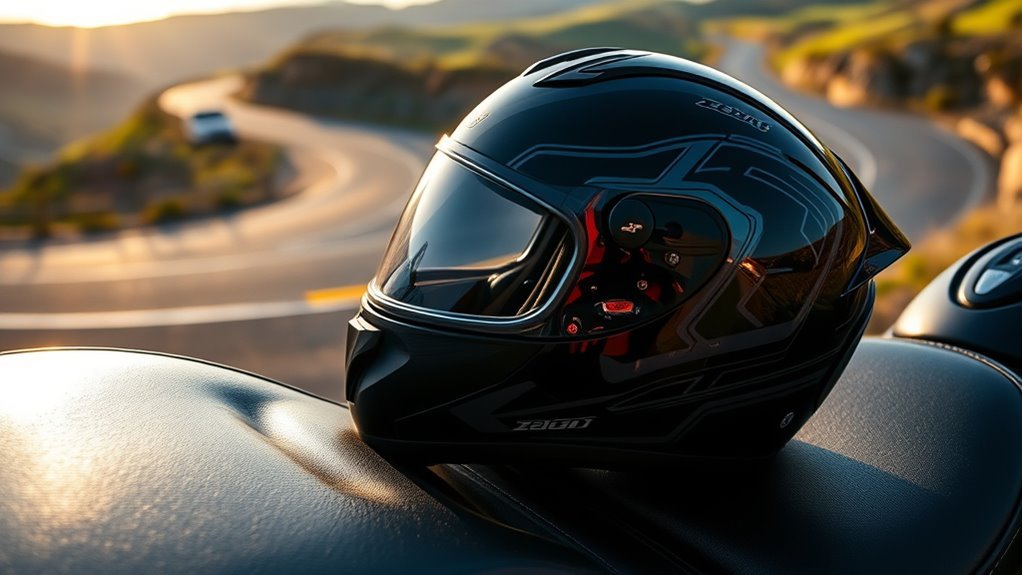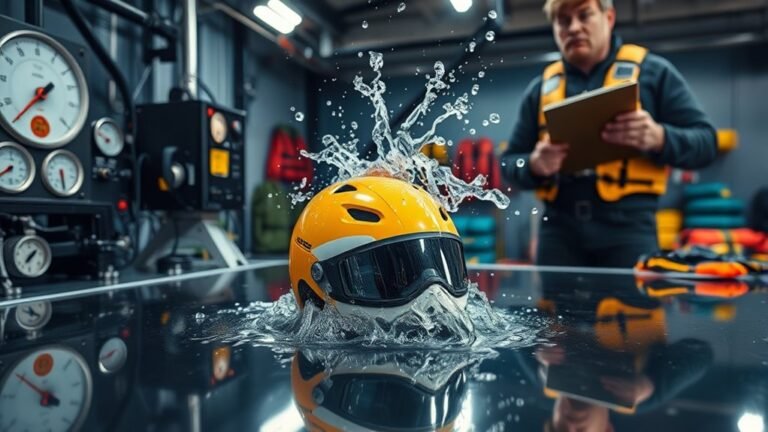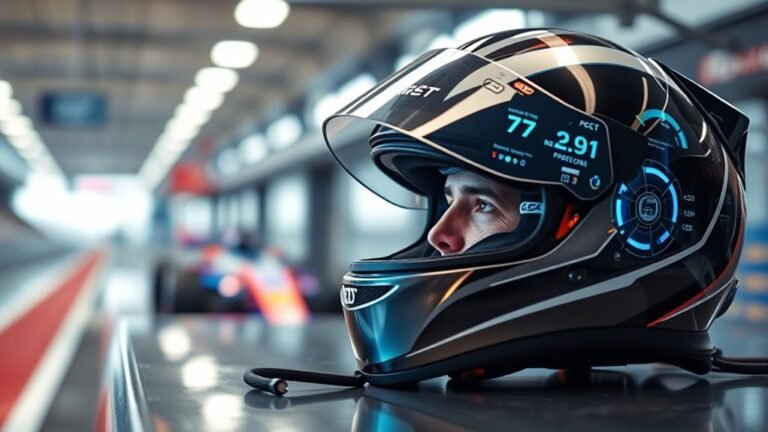Best Motorcycle Helmets for Long-Distance Rides
When choosing the best motorcycle helmets for long-distance rides, prioritize comfort, fit, and safety features. Full-face helmets offer maximum protection, while modular designs provide versatility. Open-face helmets enhance visibility but compromise on wind resistance. Look for lightweight options to reduce neck strain and guarantee effective ventilation for comfort. Renowned brands like Arai and Shoei deliver quality models. Proper fit and maintenance are essential for longevity and performance. If you want to explore more details, there’s much to reflect on.
Importance of a Quality Helmet for Long-Distance Riding
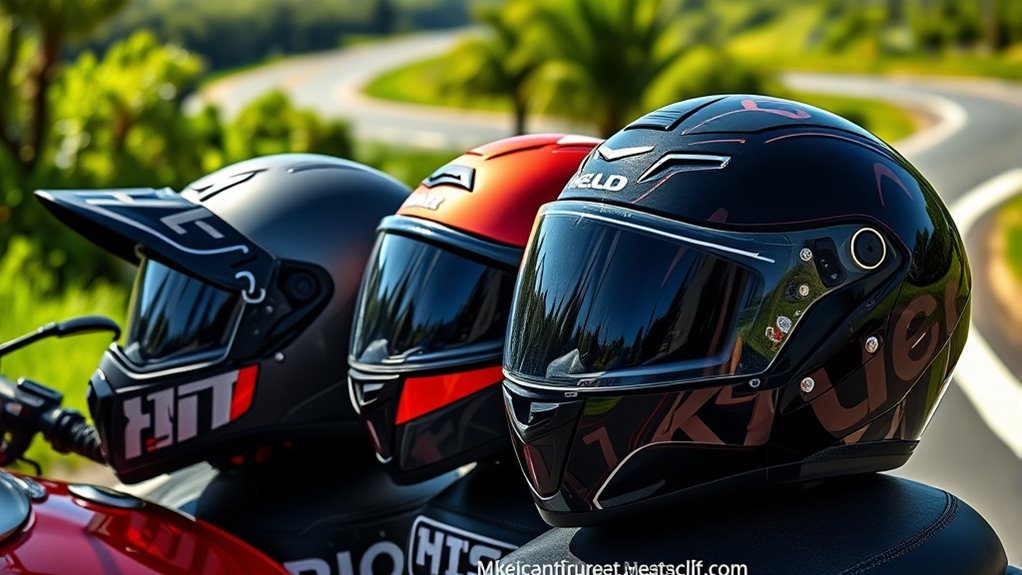
When you commence on long-distance rides, the importance of a quality helmet can’t be overstated. A well-constructed helmet not only protects your head but also enhances your riding experience. Helmet longevity is essential; high-quality helmets are built to withstand the wear and tear that comes with frequent use. They maintain their protective qualities longer than cheaper alternatives, ensuring consistent rider safety over time. Furthermore, a reliable helmet minimizes the risk of injury in case of an accident, offering peace of mind as you traverse vast landscapes. Additionally, comfort features, such as ventilation and padding, contribute to a more enjoyable ride, allowing you to focus on the freedom of the open road. Choose wisely; your helmet is critical for both safety and experience.
Key Features to Look for in Long-Distance Motorcycle Helmets
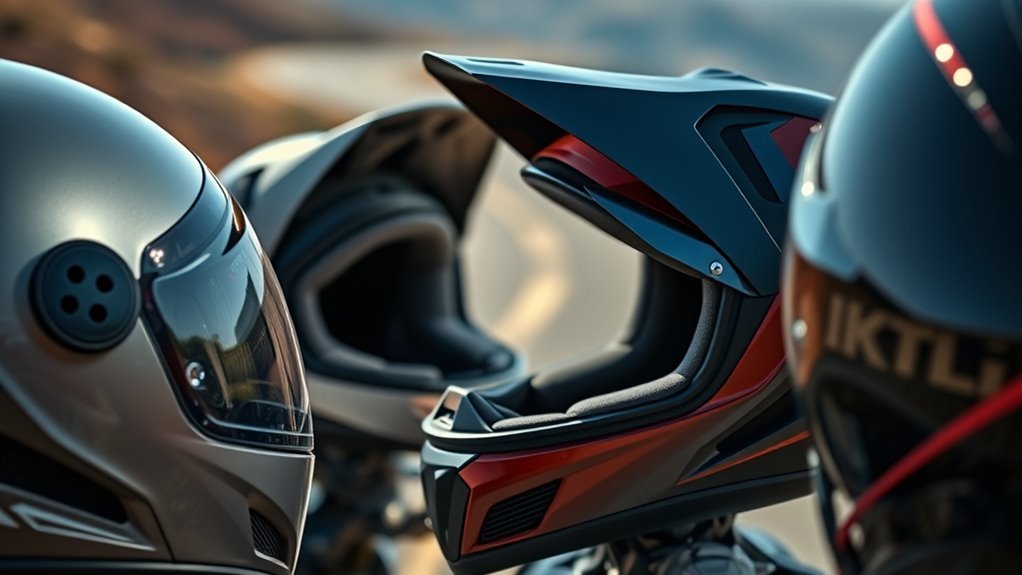
When choosing a helmet for long-distance rides, comfort and fit are essential to guarantee you can ride for hours without discomfort. Additionally, effective ventilation and noise control greatly enhance your experience, allowing you to focus on the road ahead. Understanding these key features will help you select a helmet that meets your long-distance riding needs.
Comfort and Fit
Comfort and fit are paramount in selecting a motorcycle helmet for long-distance rides. You want a helmet that molds to your head without pinching, leveraging quality padding materials for long-term comfort. Guarantee you’re aware of proper helmet sizing; an ill-fitting helmet can lead to discomfort and distraction.
| Feature | Importance | Impact on Ride |
|---|---|---|
| Padding Materials | Reduces pressure | Enhances comfort |
| Helmet Sizing | Guarantees snug fit | Maximizes safety |
| Weight | Affects neck strain | Influences endurance |
| Retention System | Secures helmet | Boosts confidence |
Ventilation and Noise Control
Effective ventilation and noise control are essential in a motorcycle helmet, especially for long-distance rides. When you’re out on the open road, proper airflow management keeps you comfortable and focused, while effective sound insulation protects your hearing from wind noise and engine rumble. Here are key features to look for:
- Ventilation Ports: Guarantee there are adjustable vents to customize airflow according to your needs.
- Chin Bar Design: A well-designed chin bar can help minimize turbulence and reduce noise.
- Padding Materials: High-quality padding enhances both comfort and sound insulation, creating a more enjoyable ride.
When choosing a helmet, prioritize these aspects to enhance your freedom on long rides, guaranteeing you stay refreshed and alert.
Full-Face Helmets: Best for Maximum Protection

When considering full-face helmets for long-distance rides, safety standards compliance is essential to guarantee adequate protection. You’ll also want to evaluate comfort features that can notably enhance your riding experience over extended periods. Additionally, effective ventilation and noise control are vital for maintaining focus and reducing fatigue on long journeys.
Safety Standards Compliance
While many riders prioritize style and comfort in their choice of helmet, safety should always be the foremost concern, especially for long-distance journeys. Full-face helmets offer maximum protection, but it’s essential to guarantee they comply with safety certifications and testing standards.
When selecting your helmet, consider:
- DOT, ECE, or Snell certifications: These indicate rigorous safety testing.
- Impact resistance: A helmet should withstand significant force to protect your head.
- Retention system: A secure fit keeps the helmet in place during an impact.
Comfort for Long Rides
Choosing a helmet that meets safety standards is just the beginning; comfort plays a pivotal role in your riding experience, especially on long journeys. When selecting a full-face helmet, consider the quality of helmet padding and its ergonomic design. High-density foam padding not only cushions your head but also helps distribute pressure evenly, reducing fatigue. An ergonomic design guarantees that the helmet fits snugly without causing discomfort, allowing you to focus on the road ahead. Look for helmets that feature adjustable padding or removable liners, which can enhance comfort during extended rides. Ultimately, a helmet that combines robust safety features with superior comfort will empower you to explore freely and fully enjoy your adventure on the open road.
Ventilation and Noise Control
A well-ventilated helmet can greatly enhance your riding experience, especially on long-distance journeys. Ideal airflow design keeps you cool, reducing fatigue and discomfort. You’ll want a helmet that balances ventilation with effective sound insulation, ensuring you enjoy the ride without excessive noise interference.
- Look for adjustable vents to customize airflow.
- Prioritize materials that absorb sound without compromising safety.
- Consider a full-face design for maximum protection and better noise control.
Modular Helmets: The Versatile Choice for Riders
Modular helmets stand out as a versatile choice for riders who value both convenience and safety. With their unique design, you can easily flip up the chin bar, offering a seamless changeover from full-face protection to an open-face experience. This helmet versatility is perfect for long-distance rides, allowing you to communicate, take a sip of water, or enjoy the breeze without removing your helmet. The modular advantages also include improved airflow, making it easier to regulate temperature during long journeys. Additionally, many models boast advanced safety features and comfort padding, ensuring you feel secure and relaxed. For riders seeking freedom on the road, modular helmets deliver flexibility without compromising protection.
Open-Face Helmets: Pros and Cons for Long Rides
While open-face helmets offer a distinct sense of freedom, they come with their own set of advantages and disadvantages for long-distance rides.
Open Face Benefits:
- Enhanced visibility and airflow, keeping you cool on hot days.
- Lightweight design reduces neck strain during long rides.
- Offers a more open riding experience, connecting you with your surroundings.
Open Face Drawbacks:
- Less protection against wind, debris, and impacts compared to full-face helmets.
- Limited facial coverage may lead to discomfort from cold weather or rain.
- Reduced noise insulation, which can be tiring on extended journeys.
Ultimately, it’s essential to weigh the open face benefits against the drawbacks to decide if this helmet style suits your long-distance riding needs.
Lightweight Helmets: Enhancing Comfort on the Road
When you’re on a long-distance ride, a lightweight helmet can greatly enhance your comfort. Its design reduces neck strain, allowing you to ride longer without discomfort. Additionally, many lightweight helmets offer improved ventilation, keeping you cool and focused on the road ahead.
Importance of Lightweight Design
A lightweight helmet can greatly enhance your comfort during long-distance rides, as it reduces fatigue and strain on your neck and shoulders. When you’re on the open road, you want to feel free and unencumbered. Lightweight designs improve aerodynamic efficiency and guarantee ideal weight distribution, making your ride smoother and more enjoyable.
- Improved maneuverability: A lighter helmet allows for easier head movements, enhancing your awareness of surroundings.
- Extended ride time: With reduced fatigue, you can ride longer without discomfort.
- Better ventilation: Many lightweight helmets feature advanced ventilation systems, keeping you cool during long trips.
Choosing a lightweight helmet isn’t just about safety; it’s about enhancing your entire riding experience.
Impact on Neck Strain
Lightweight helmets greatly reduce neck strain, which is essential for riders starting on long journeys. When you’re on the road for hours, the last thing you want is a heavy helmet weighing you down and creating discomfort. Modern lightweight helmets often feature an ergonomic design that distributes weight evenly, ensuring superior neck support. This design minimizes the strain on your neck muscles, allowing you to maintain better posture and focus on the ride ahead. With less fatigue, you can enjoy more freedom and control over your motorcycle. Investing in a lightweight helmet isn’t just about comfort; it’s about enhancing your overall riding experience, enabling you to conquer those long distances with ease and confidence.
Ventilation for Comfort
Although comfort is often associated with weight, effective ventilation plays an essential role in enhancing the overall riding experience. When you’re on long-distance rides, the right helmet can notably improve airflow dynamics, keeping you cool and focused. Helmets equipped with advanced cooling technology help manage heat and moisture, ensuring comfort during extended journeys.
- Look for helmets with adjustable vents for personalized airflow.
- Consider models with moisture-wicking liners to reduce sweat buildup.
- Opt for designs that enhance airflow without compromising safety.
Noise Reduction and Ventilation Features
When choosing a motorcycle helmet for long-distance rides, it’s essential to reflect on how well it manages noise and airflow. Effective sound isolation is vital; a helmet that minimizes wind noise allows you to enjoy the ride without distractions. Look for models with advanced padding and aerodynamic designs that reduce turbulence.
Equally important is airflow efficiency. A helmet with adjustable vents can enhance comfort by regulating temperature and moisture, ensuring you stay cool on long journeys. Balancing sound reduction with proper ventilation is key to maintaining focus and comfort. When you’re riding for hours, a helmet designed with these features can make a significant difference, allowing you to fully embrace the freedom of the open road.
Top Brands for Long-Distance Motorcycle Helmets
Finding a helmet that balances noise reduction and ventilation is just one part of the equation for long-distance riders. You’ll want to take into account top brands known for quality and comfort to guarantee an enjoyable journey. Here are some standout options based on helmet reviews:
- Arai: Renowned for their superior fit and safety features, ideal for long rides.
- Shoei: Offers fantastic aerodynamics and excellent noise control, perfect for extended highway journeys.
- Schuberth: Known for their innovative designs and premium comfort, making them a favorite among touring riders.
Choosing a reliable helmet is vital for your freedom on the road. Researching these top brands will help you find the perfect companion for those long-distance adventures ahead.
How to Properly Fit a Motorcycle Helmet
To guarantee maximum protection and comfort during long rides, properly fitting a motorcycle helmet is essential. Start with accurate helmet sizing; measure your head circumference just above your eyebrows. Refer to the manufacturer’s sizing chart, as sizes can vary by brand. When trying on a helmet, verify it fits snugly without causing discomfort. You shouldn’t feel any pressure points, and the helmet shouldn’t shift when you move your head. Consider the helmet materials too—polycarbonate shells offer lightweight durability, while fiberglass composites provide superior strength. Always check for a snug fit around the cheeks and forehead, confirming that the helmet doesn’t lift off your head at high speeds. A proper fit enhances safety and enhances your riding experience.
Maintenance Tips for Your Motorcycle Helmet
Although maintaining your motorcycle helmet might seem straightforward, neglecting proper care can affect both its longevity and safety. Regular helmet cleaning and visor maintenance are essential practices for any rider. Here are some tips to keep your gear in top shape:
- Clean the outer shell with a mild soap and water solution; avoid harsh chemicals.
- Inspect the visor for scratches or damage, replacing it if necessary for ideal visibility.
- Store your helmet in a cool, dry place, away from direct sunlight to prevent degradation.
Frequently Asked Questions
What Is the Average Lifespan of a Motorcycle Helmet?
The average lifespan of a motorcycle helmet is about five years, but it can vary based on helmet safety standards and maintenance. Regularly inspect your helmet for cracks or damage, and store it in a cool, dry place to prolong its life. If you’ve been in an accident, it’s essential to replace it immediately, even if it looks fine. Prioritizing proper care guarantees you stay safe and free on the open road.
Can I Use a Motorcycle Helmet for Other Activities?
You can use a motorcycle helmet for other activities, but its suitability largely depends on the safety standards of those activities. For instance, while it might protect your head during skateboarding or cycling, it isn’t designed for sports like hockey or climbing, where specific helmets offer better protection. Always consider the activity’s nature and the helmet’s design to guarantee you’re prioritizing safety while embracing your adventurous spirit.
Are There Specific Helmets for Different Weather Conditions?
Yes, there are specific helmets designed for different weather conditions. When you ride in varying climates, look for helmets with excellent weather adaptability and helmet ventilation. For hot weather, a well-ventilated helmet helps keep you cool, while in colder conditions, a full-face helmet with a snug fit provides warmth. Some helmets even feature removable liners to accommodate changing temperatures, ensuring your ride remains comfortable, no matter the weather you encounter on your journey.
How Do I Store My Motorcycle Helmet Properly?
“An ounce of prevention is worth a pound of cure.” To store your motorcycle helmet properly, keep it in a cool, dry place away from direct sunlight. Use a helmet bag to protect it from dust and scratches. Make certain it’s well-ventilated to prevent moisture buildup, which can damage the interior. Regular cleaning and proper maintenance will extend its lifespan, allowing you to enjoy the freedom of the open road safely and comfortably.
What Are the Signs That I Need to Replace My Helmet?
You should replace your helmet if you notice a cracked shell or significant padding wear. A cracked shell compromises safety, reducing impact protection during a crash. Additionally, if the padding feels compressed or degraded, it can affect comfort and fit, leading to distractions while riding. Regularly inspect your helmet for these signs, and if you see them, don’t hesitate to invest in a new helmet for your freedom on the road.
